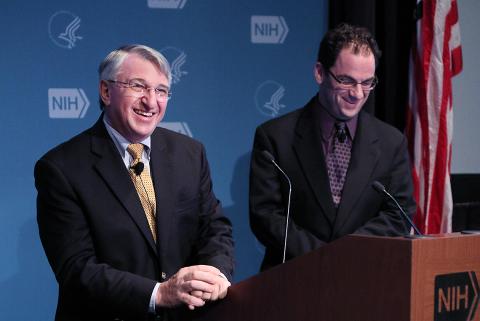NCI Team Discusses Transplantation Advances

Photo: Chia-Chi Charlie Chang
There’s something about cyclophosphamide. Administered to patients who have undergone hematopoietic stem cell transplantation, the drug is highly effective in preventing one of the most common, and deadly, post-transplant complications—severe graft vs. host disease (GVHD).
Over the last 50 years, there has been what Dr. Ronald Gress calls a dramatic evolution in hematopoietic transplant therapy. Chief of NCI’s Experimental Transplantation and Immunology Branch and deputy director of the Center for Cancer Research, he has been on the frontier of transplantation biology since his arrival at NIH.
At Clinical Center Grand Rounds recently, Gress and colleague Dr. Christopher Kanakry, assistant clinical investigator in the same branch, outlined advances in what is not only replacement therapy for a patient’s immune system but also the first form of effective immunotherapy.
The infused stem cell product, used mainly in cancer patients, “carries an immune system with it,” Gress noted.
It is no longer as important as it once was to find matched donors for transplant. So-called allogeneic transplant—meaning genetically similar, but not identical—has long required that the donor and recipient are genetically matched at what is called the human leukocyte antigen (HLA) region. Based on recent advances, using donors not fully matched at this region is now possible. “Almost everyone now has a donor,” Gress noted.
Historically, there have been four major obstacles to allogeneic stem cell transplant, he explained: Graft rejection, GVHD (either acute or chronic), relapse (which represents a failure of the immunotherapeutic graft vs. leukemia or graft vs. tumor effect of transplant) and immune incompetence, which endures years after transplantation in adults.
“The mission of our branch is to overcome these four,” said Gress, “with a goal of curative hematopoietic stem cell transplantation.”
All four obstacles arise, one way or another, from T cells—“They are tied together in a knot, so to speak,” said Gress.
Twenty years ago, in hematopoietic stem cell transplantation, the recipient underwent myeloablation, or complete elimination, via chemicals or radiation, of his or her bone marrow. Today, immune-ablation, or targeted removal of host T cells, is a new standard. Both processes deplete a patient’s T cells (the T is for thymus, where these immune cells are educated).
There are two paths to T-cell reconstitution in transplant patients: the thymic-dependent T-cell pathway and the peripheral expansion pathway. If a patient is young enough and the amount of prior chemotherapy or radiation exposure is not extreme, the thymus produces the crucial T cells. Adults depend on the peripheral path. Gress and his team are trying to correct flaws in both sources of T cells.
In order to increase the peripheral pool of T cells, NCI scientists have had some success with IL-7, a homeostatic cytokine. A new trial using IL-7 is currently being designed, said Gress.
“In 3 years, this talk will be very different,” he said. “The field is very fast-moving.”
Kanakry, who trained at Johns Hopkins—one of the pioneering centers, along with Fred Hutchinson Cancer Research Center, of the hematopoietic cell transplantation field—noted that only 30 percent of transplant patients have an HLA-matched related donor. Thanks to cyclophosphamide, which is effective not only against GVHD but also in preventing rejection of the new immune system, it is no longer necessary to strive for identical HLA-matching.
“There is less burden of immunosuppression therapy, too,” he said. “It is fast becoming the standard treatment around the world for patients without a matched donor. And it’s inexpensive and easy to administer.”
As effective as cyclophosphamide is, Kanakry said very little is known about how it actually works. He has spent the past few years trying to understand that. Cyclophosphamide, one of the oldest anti-cancer drugs in the arsenal, is now being repurposed for GVHD prevention.
The dose of cyclophosphamide is crucial, Kanakry pointed out; both too little and too much are unhelpful to patients. It is also effective even if the patient lacks a thymus.
Relapse is the leading reason allogeneic hematopoietic stem cell transplants fail, Kanakry said. He hopes that a complete understanding of how cyclophosphamide works will allow him to rationally integrate other therapies to decrease this major remaining barrier to successful transplants.
The full talk is available at https://videocast.nih.gov/summary.asp?Live=27681&bhcp=1.
